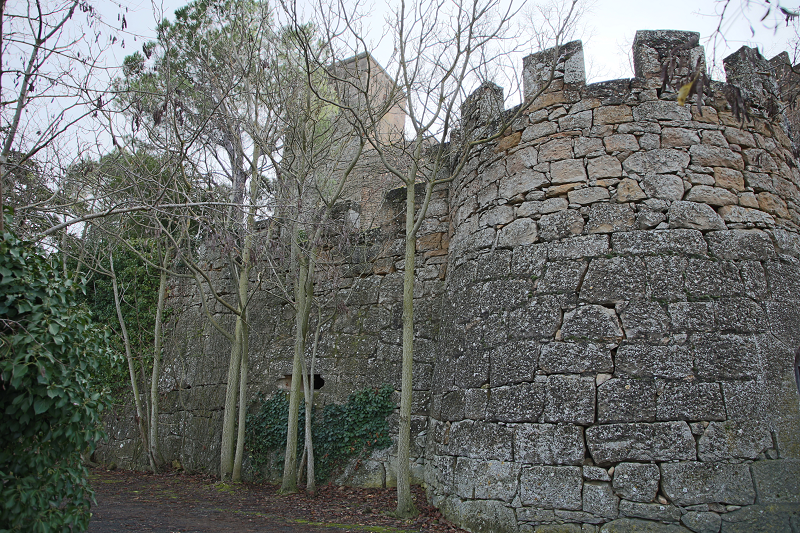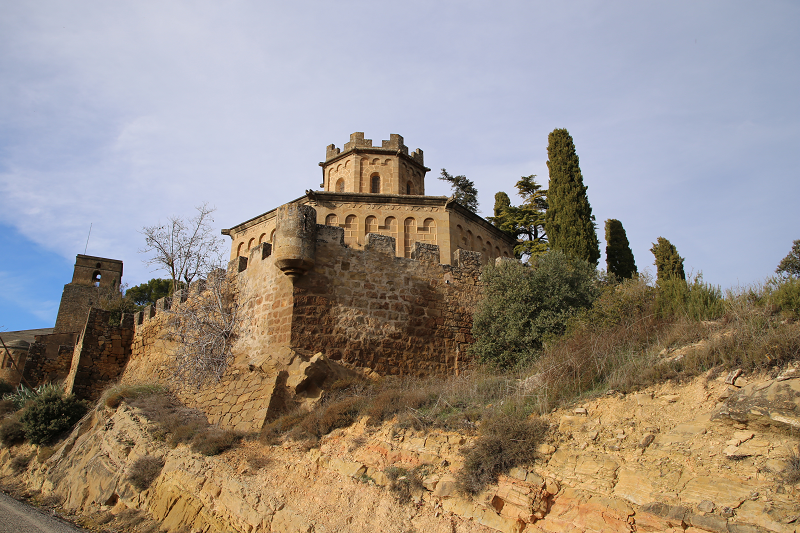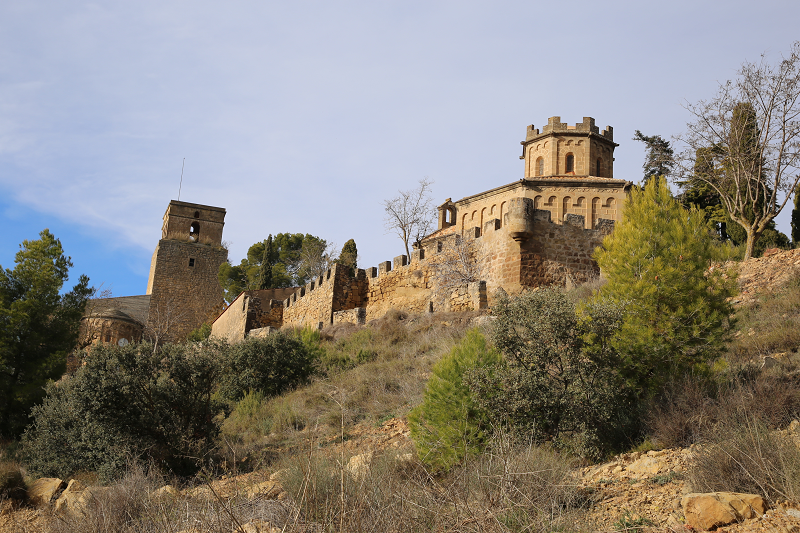Castle Ribelles (cat. Castell de Ribelles)
This castle belongs to the city line of Vilanova de l’Aguda (cat. Vilanova de l’Aguda) in the Noguera region, Lleida province, Catalonia, Spain, and deservedly bears the title of an object of cultural heritage of all Spanish significance. It joined the line of defense that stretched along the right bank of the Llobregos River (cat. Llobregós). Nowadays, it has become one with the church building and the cemetery, where the original chapel and the pantheon of the local barons are preserved. In the early twentieth century, the castle was almost completely rebuilt. It sits on a high hill, below which houses nestled, forming the small village Ribelles in the valley of the Llobregos river.
Castle Ribelles crowns the hill on which the village of the same name is located. The castle is a whole complex of buildings, covering a large space, measured in square meters and in centuries – from X to XX. The most ancient elements are the square tower and the adjacent Romanesque church of St. Mary in Ribelles (cat. Santa Maria de Ribelles).
The square tower is 515 cm wide (inside). One can discern the stages of construction of this structure. In the lower part, up to a height of about 9 meters, the tower is made of large stone blocks about 60 x 35 cm in size (from the outside), carefully hewn and fitted, while the formwork is facing the inside of the tower. The wall thickness reaches 175 cm. At this level, from the northeast side, there are two loopholes, possibly made already in the modern era, while on the north side there are traces of another, now mortgaged loophole. At a height of 9 to 13 meters, the walls of the tower become thinner from the inside (165 cm). Masonry, also from large and carefully hewn stones, becomes visible from the inside. On the western wall, at a height of about 11 meters, a 120-cm wide doorway was created, ending in a semicircular arch. To the inside of the wall, the opening narrows and its width is only 80 cm.
At a height of 13 meters there is another floor, which turned the tower into a bell tower. It is a square superstructure, smaller in width than the body of the tower. The masonry consists of carefully hewn stones, laid in even rows, with three openings for the bells on the southern facade and one window on each of the three remaining sides. At the turn of the XIX and XX centuries, the castle was repaired, which could be called a comprehensive restructuring and even the creation of the castle again in the Neo-Romanesque style, following the fashionable principle of historicism and popularization of Romanesque architecture.
In general, judging by the layout and construction, the oldest part of the tower appeared before the year 1000. The next phase, a segment at a height of 9 to 13 meters, can be dated to the XII century. In the Middle Ages, other military buildings may have been added to the tower, which later disappeared. In the 17th century, the tower was built on to be used as a bell tower; in this form it has survived to the present day. Then, in the XIX – XX centuries, there were buildings that form the current ensemble of the castle, today in a dilapidated state.
The Church of St. Mary in Ribelles is adjacent to the tower of the castle. This is a single-nave structure with a sailing roof, which in later times replaced the original box roof, from which some elements remained. In the eastern part, the nave ends in a semicircular apse, which is connected to the nave by a narrow presbyterial arch. The entrance, which also changed its original position over time, opens onto the western facade, and a pair of windows extending outward opens onto the southern facade, as does the window in the center of the apse. A fourth window opens onto the western facade, which has greatly changed from its original appearance.
The most prominent element, especially after the restoration, is the apse, on which, under a layer of plaster, appears the belt of Lombard arches, grouped in pairs, which rest on a high plinth, which, in turn, rests on the first plinth adapted to the level of the rock.
The masonry consists of neatly hewn stones, laid in even rows, which makes it possible to date a building that fully fits into the standards of Lombard architecture, of the 11th century.
As a result of the restructuring performed in the twentieth century, all the buildings were combined into an ensemble consisting of a castle, a church and a cemetery. During the restoration works in the apse, a painting was found that could correspond to the 14th century.
Ribelles Castle was part of the line of defense that ran along the right bank of the Llobregos River.
The ancient Barony of Ribelles included the townships of Ribelles, L’Alzina (cat. L’Alzina), Guardiola (cat. Guardiola), and Vilalta (cat. Vilalta). Its name is associated with the surname of the barons Ribelles, about whom a lot of documentary evidence remained from the XI century and played an important role in the acquiring and settling of vacant lands under the earls of Urgell, as well as in other outstanding political and military events undertaken by these earl-kings.
Despite the possible Islamic origin of the building, one of the first mentions of the Ribelles castle between 1042 and 1075 was the verdict that the viscount Miro d’Urgell passed on (cat. Vescomte Miró d’Urgell) about the litigation between the bishop of Urgell Wilhelm (cat. Guillem d’Urgell ) and Ramon de Ribelles (cat. Ramon de Ribelles) regarding the boundaries between the lands of the Gissons and Ribelles castles.
In 1047, the castle of Ribelles and the castle of Figuera de l’Aguda (cat. Figuera de l’Aguda) are referred to as east of the castle of Aguda (cat. L’Aguda); further, there is still a mention of the castle from 1067 – a record of how Ramon and his wife Gill (cat. Guilla) sold the patrimony situated in the lands belonging to the castle Ribelles in the place, called Pujol (cat. Pujol) to the monastery of St. Saturnin of Tavèrnoles (cat. Sant Serni de Tavèrnoles). Apparently, the first of the clan Ribelles, Gombau I (cat. Gombau I) and Ramon I, mentioned in the sources of the XI century, were vassals of the Counts of Cerdanya (cat. Comtes de la Serdanya) as owners of Castelnou d’Oluge castles (cat. Castellnou d’Oluja), Manresana (cat. Manresana), Brufaganes (cat. Brufaganyes) and Olujes (cat. Olujes). Later, Ponce I (cat. Ponç I) and Gombau III Ribeleses, descendants of the previous ones, were referred to in 1149 as participants in the Battle of Lleida (cat. Lieida) under the command of Count Ermengol VI Urzhelsky (cat. Ermengol VI d’Urgell), who received allotments from him.
The same Gombau III signed the charter of settlement as a witness, which the counts issued to this city, and then mentioned in 1166 in the act of laying the foundation of the monastery of St. Mary in Bellpuche de les Avellanes (cat. Santa Maria de Bellpuig de les Avellanes). A little later, in 1174, together with his wife Marquise Cabrera, Mrs. Arteza de Segré, Montsonis, Foradada and Les Ventoses (cat. Senyora d’Artesa de Segre, Montsonís, Foradada i les Ventoses), he left his signature on the charter of the settlements, which the Counts of Urgell, Ermengol VII and Dolsa (cat. Dolça), were given to the inhabitants of Balaguer; next to their signatures are the names of some members of the clans Anglesole, Concabella (cat. Concabella) and Torroja (cat. Torroja), who also played a prominent role in the feudal conquest of the territories of western Catalonia.
At the beginning of the 15th century, one of the branches of this clan settled in Sardenya (cat. Sardenya). At the same time, the numerous family of Ribelles, ruling various castles of the Urgell county and the Solsones region (cat. El Solsonès), Segarra (cat. La Segarra) and the Tremp Valley (cat. Conca de Tremp), lost contact with the Baroness of Ribelles. Between 1404 and 1416, the Balaguer Monastery of St. Clara (cat. Monestir de Santa Clara de Balaguer), who appointed the mayor and probably owned some land that could have been pledged near the castle, serves as the lord Ribelles. Be that as it may, in 1418 Ramon Ponce de Ribelles (cat. Ramon Ponç de Ribelles) sold the barony of Ribelles to his second cousin Gispert de Ponts, Señor de Tarrega (cat. Gispert de Ponts, senyor de Tàrrega). This act put an official end to the clan’s connection with its original nest, and from 1418 the barons of these places began to be called “de Ribelles de Ponts” (cat. De Ribelles de Ponts).
Later, in 1671, Pere de Ponts and de Guimerà (cat. Pere de Ponts i de Guimerà) sold the barony to Francesca de Montserrat, the first Marquis of Tamaritus (cat. Francesc de Montserrat, primer marques de Tamarit). This deal was challenged by his niece Maria Theresa de Ponts and de Ros (cat. Maria Teresa de Ponts i de Ros), who won a lawsuit in 1702. However, the barony soon returned to Tamarite’s marquis, who sold it to his family Duran (cat. Duran), and they, in turn, around 1871, sold it to Josep Bofarul and Rafart (cat. Josep de Bofarull i Rafart), and in 1872, King Amadeus I (cat. Amadeu I) confirmed this title to him as part of the Spanish crown. Subsequently, the barony passed to the Ljabres family (cat. Llabrés), living in Palma de Mallorca, and it was they who began the restoration of the castle. To date, the castle remains in the ownership of the Barons of Llabres.
The history of the parish church is closely connected with the castle Ribelles and his lords. One of the first mentions of the church is contained in a document dated 1141: the Bishop of Urzhel, Pere (cat. Pere), gave the church of Ribelles, with all its property and dependencies, to the capitulum of St. Mary of Urgell’s (cat. Canònica de Santa Maria de la Seu) churches. Control over the income of the church inevitably led to conflicts between the barons and the Urgel canons. Indeed, this situation was reflected in the agreement signed on June 6, 1187 between the Urgel Chapter and Gombau de Ribelles (cat. Gombau de Ribelles), his wife Marquis and their sons, Gombau and Ramon, with the mediation of Archbishop Tarragona Berenguer de Vilademuls ( cat. Berenguer de Vilademuls).
The agreement referred to half of the tithe from Montferrer (cat. Montferrer) and other places, among which the church of St. Mary is mentioned in Ribelles. By virtue of this agreement, the capitulum of St. Mary of Urgell was received by the church of Ribelles, who was forever freed from any other burden. At the same time, according to the same treaty, the clan Ribelez received from Arnau the bishop of Urgell (cat. Bisbe Arnau d’Urgell) the sum of one hundred maravedi.
In the following years, the church of Ribelles is often mentioned among the parishes of the Urgell Diocese, for example, in the tax church documents for 1279, 1280 and 1391; in this last of these years, the rector of the church in Ribelles was Guillem de Castellar (cat. Guillem de Castellar), who was at the same time the beneficiary of the church in Sarauja (cat. Saraüja).

















